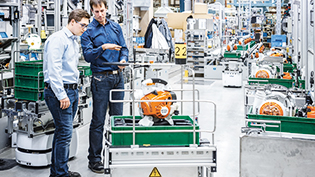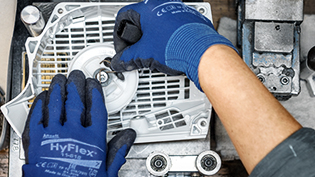A Professional Tool for Stihl
In large, heavily-specialised production facilities, such as those belonging to STIHL, it is vital that both management and maintenance are able to keep track of all aspects of their production. Thanks to the version control software from AUVESY-MDT, time-consuming searches for data and documentation have long since become a thing of the past.

The Initial Situation
Stihl is one of the world's leading manufacturers of chain saws and power tools for forestry, agriculture, landscaping and gardening. Maintenance in the Stihl factories is organized in two areas. Each division has its own teams that manage day-to-day operations and are familiar with the equipment. In addition, there's a central maintenance pool of specialists available on site as needed. The proximity of the Waiblingen and Ludwigsburg plants promotes an active exchange of knowledge, which is also maintained internationally with plants in Switzerland, the USA, Brazil and China.
With the advent of the data backup era, data management at Stihl was relatively straightforward. However, the transition to backups on floppy disks, and later on USB sticks, posed increasing organizational challenges. There was a risk of data loss, which could affect maintenance and production. The introduction of the AUVESY-MDT version control software was driven by the desire to optimize processes and make data management more efficient.
The Solution
The decision for the AUVESY-MDT version control software was based on its ability to integrate different equipment and production areas. Stihl uses the software in Waiblingen, Germany, where it's used by about 220 employees for various purposes - not only in manufacturing, but also in building technology and quality assurance.
The software offers differentiated access rights, which are crucial for meeting the different requirements of the various departments. Access rights are particularly strict in plant engineering, especially for knowledge-intensive equipment. It's important that the version control software provides differentiated access rights to meet the needs of different departments.
Another advantage of the software is the ability to revert to previous versions during plant construction to react flexibly to changes. This is particularly important for optimizing the plant development process and ensuring that adjustments can be made efficiently.
Users appreciate the efficiency of the software, especially the ability to quickly access all necessary information about the equipment. This often significantly reduces equipment downtime and contributes to increased productivity.
The version control software from AUVESY-MDT is a well-rounded tool that has helped us simplify our work immensely. Functions such as version compare are even better than the solutions offered by individual device manufacturers. This is what makes the software so attractive!

The Result
The implementation of the AUVESY-MDT version control software has led to significant improvements in data management at Stihl. Currently, about 3,000 pieces of equipment in the German Stihl factories, consisting of about 7,600 software components, are archived in the software. By default, each piece of equipment is divided into three defined components: software, schematics, and documentation. This structure provides flexibility, as additional components for robot or screwdriver control can be added as needed. The documentation includes various formats such as PDF documents and Excel spreadsheets.
Since data collection began, more than 46,000 versions have been archived. Despite this large amount of data, the server storage requirement is less than 1.5 GB. This efficiency demonstrates the power of the software and enables effective management of production data. Extensive archiving allows Stihl teams to quickly access previous versions and make changes as needed. This increases flexibility and responsiveness in the production process, ultimately contributing to greater efficiency and quality.
Thomas Ruppmann emphasizes the software's positive return on investment. It's difficult to quantify the benefits in terms of dollars, but the advantages are clear, especially when it comes to soft factors such as transparent and traceable documentation. "The effort of searching for the latest software version has completely disappeared. We always know where to go," says Ruppmann. Financial savings are a pleasant side effect, as there is no longer any need to search for current software versions, and quality assurance is ensured by using the latest versions.
Contact us
Want to learn more about automatic backups, versioning and documentation in automated production?
Contact us
